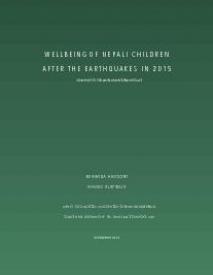Wellbeing of Nepali children after the earthquakes in 2015 : Narratives of children parents and teachers
The Early Childhood Education Centre Kathmandu, Nepal, asked us to do qualitative research into the wellbeing of Nepali children after the earthquakes in 2015 and what the factors were that helped the wellbeing to increase.
We are interested in working with children and have the desire to mean something to them. We were enthusiastic about the work of the Early Childhood Education Centre when we heard about it. The Early Childhood Education Centre is working in Nepal to improve the quality of early childhood education by training teachers to focus on the socio-emotional development of the children instead of cramming knowledge. After the earthquakes in 2015, the Early Childhood Education Centre tried to teach the teachers and parents how they could help their children in overcoming this event. In consultation with our tutors, we came to the following main question; ‘’How did the Nepali children from pre-primary schools in the Kathmandu Valley, experience their wellbeing after the earthquakes in 2015 and what are helping factors that influences the wellbeing of children after an earthquake?’’ You can imagine that devastating events like earthquakes have a big influence on children. After traumatic events, often psychological interventions are used to process the events. But you can also start with the more basic interventions. The goal of this research is to describe which factors helped the children to increase their wellbeing after the two earthquakes of April and May 2015. We got results through literature research and interviews with respondents; children, parents and teachers. Through their narratives we heard how the children perceived their wellbeing and what the role of their parents and teachers was therein. By connecting this to literature, we have an overview of factors that can be helpful in processing a traumatic event. Besides this, we evaluated the goals of the Community Healing Course, a post-earthquake training for parents and teachers, developed by the ECEC and given after the earthquake. The results of this research show us that children often benefit from basic needs and the recovery of normal daily life. It also makes clear how difficult it is to implement more complex interventions in Nepal, because the concept ‘trauma’ is hardly known and adults are struggling with understanding the perception of their children. This research has brought a list of narratives of the respondents, a list of recommendations regarding the Community Healing Course and a flyer which can be used in post-trauma trainings. The ECEC can use this information to adjust the CHC. In this way the ECEC will be able to respond even better to the needs of children after a traumaic event.
Geachte bezoeker,
De informatie die u nu opvraagt, kan door psychotraumanet niet aan u worden getoond. Dit kan verschillende redenen hebben,
waarvan (bescherming van het) auteursrecht de meeste voorkomende is. Wanneer het mogelijk is om u door te verwijzen naar de bron
van deze informatie, dan ziet u hier onder een link naar die plek.
Als er geen link staat, kunt u contact opnemen met de bibliotheek,
die u verder op weg kan helpen.
Met vriendelijke groet,
Het psychotraumanet-team.
95 pages | Ede : Christian University of Applied Sciences Ede
bachelor thesis


